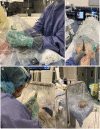Pediatric Airway Management in COVID-19 Patients: Consensus Guidelines From the Society for Pediatric Anesthesia's Pediatric Difficult Intubation Collaborative and the Canadian Pediatric Anesthesia Society
- PMID: 32287142
- PMCID: PMC7173403
- DOI: 10.1213/ANE.0000000000004872
Pediatric Airway Management in COVID-19 Patients: Consensus Guidelines From the Society for Pediatric Anesthesia's Pediatric Difficult Intubation Collaborative and the Canadian Pediatric Anesthesia Society
Abstract
The severe acute respiratory syndrome coronavirus 2 (coronavirus disease 2019 [COVID-19]) pandemic has challenged medical systems and clinicians globally to unforeseen levels. Rapid spread of COVID-19 has forced clinicians to care for patients with a highly contagious disease without evidence-based guidelines. Using a virtual modified nominal group technique, the Pediatric Difficult Intubation Collaborative (PeDI-C), which currently includes 35 hospitals from 6 countries, generated consensus guidelines on airway management in pediatric anesthesia based on expert opinion and early data about the disease. PeDI-C identified overarching goals during care, including minimizing aerosolized respiratory secretions, minimizing the number of clinicians in contact with a patient, and recognizing that undiagnosed asymptomatic patients may shed the virus and infect health care workers. Recommendations include administering anxiolytic medications, intravenous anesthetic inductions, tracheal intubation using video laryngoscopes and cuffed tracheal tubes, use of in-line suction catheters, and modifying workflow to recover patients from anesthesia in the operating room. Importantly, PeDI-C recommends that anesthesiologists consider using appropriate personal protective equipment when performing aerosol-generating medical procedures in asymptomatic children, in addition to known or suspected children with COVID-19. Airway procedures should be done in negative pressure rooms when available. Adequate time should be allowed for operating room cleaning and air filtration between surgical cases. Research using rigorous study designs is urgently needed to inform safe practices during the COVID-19 pandemic. Until further information is available, PeDI-C advises that clinicians consider these guidelines to enhance the safety of health care workers during airway management when performing aerosol-generating medical procedures. These guidelines have been endorsed by the Society for Pediatric Anesthesia and the Canadian Pediatric Anesthesia Society.
Conflict of interest statement
Conflicts of Interest: See Disclosures at the end of the article.
Figures




Comment in
-
In Response.Anesth Analg. 2020 Jul;131(1):e45. doi: 10.1213/ANE.0000000000004901. Anesth Analg. 2020. PMID: 32324596 Free PMC article. No abstract available.
References
-
- Dong Y, Mo X, Hu Y, et al. Epidemiological characteristics of 2143 pediatric patients with 2019 coronavirus disease in China. Pediatrics. 2020[Epub ahead of print].
Publication types
MeSH terms
Grants and funding
LinkOut - more resources
Full Text Sources
Other Literature Sources
Medical

